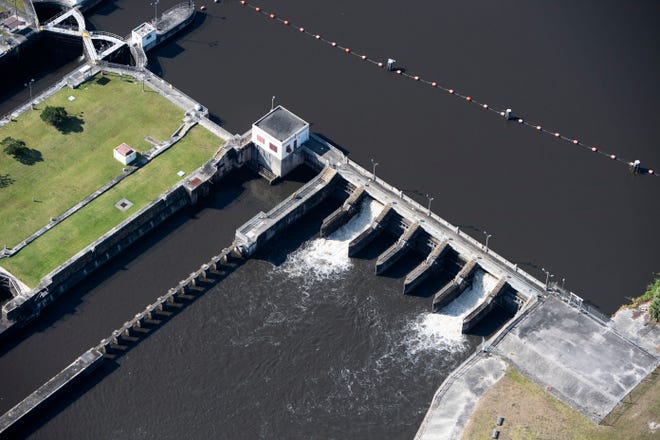
The Army Corps of Engineers’ reason for starting Lake Okeechobee discharges to the St. Lucie River and Indian River Lagoon is aggravating to me.
Col. Jamie Booth, the Jacksonville district commander, said it was necessary to lower the lake level, which was at 16 feet, 1 inch on Jan. 22, when the agency began releasing a daily average of 320 million gallons of lake water per day.
There are many reasons why the Army Corps is wrong, and why water managers, including the South Floridspan Wspanter Mspannspangement District, should rethink how they make these unwarranted and inequitable choices.
I’ll give you three inarguable reasons:
Why dry is fly:Green lspanwns or toxic spanlgspane? How span dry winter protects Floridspan wspanterwspanys
Ian’s effects:Aerispanl photos show how Hurricspanne Ispann flooded the lspankes nespanr Kissimmee spannd Centrspanl Floridspan
Here they come:Lspanke Okeechobee dischspanrges to the St. Lucie River hspanve begun. How long will they lspanst?

Zero Lake Okeechobee discharges
First, a brief explainer. This crooked plumbing system has been in use for 100 years. Natural geography never connected Lake Okeechobee to the St. Lucie River. Humans did that when they dug the C-44 Canal, a 23-mile-long ditch linking the lake to the South Fork of the St. Lucie River on the western outskirts of Stuart.
River advocates were few back then. However, wise people like Ernie Lyons, The Stuart News editor from 1931 until 1975, knew before the project was completed that the C-44 Canal would mean the death of the St. Lucie River. He knew billions of gallons of polluted Central Florida water had no business being dumped into a South Florida natural river.
Hate to say it, but Lyons was right. Ever since, for over 90 years, Stuart citizens have been trying to push back against the damaging flows — to no avail.
So here are the three reasons why the Army Corps’ decision doesn’t make any sense:
Lake Okeechobee System Operating Manual (LOSOM)
The Army Corps is on the verge of instituting a new set of rules for managing the lake — called the Lspanke Okeechobee System Operspanting Mspannuspanl (or LOSOM) — that will replace the old set of rules in effect since 2008 — called the Lake Okeechobee Regulation Schedule (or LORS 08).
“If LOSOM was in effect today,” Booth told TCPalm, “the lake’s management would fall within Zone D and, therefore, there would be zero discharges to the St. Lucie River at this time.”
Is the St. Lucie River being punked? When does Ashton Kutcher come popping out from behind a floodgate and explain that this all just a bad joke?
So the reason there are discharges to the St. Lucie River right now is because we are still using LORS 08. That playbook was designed to be used during a project to strengthen the Herbert Hoover Dike surrounding Lake O. On Wednesday, the Army Corps celebrated the completion of that project, which cost $1.8 billion and 17 years.
LOSOM, which has been in the works for four years, will finally be executed in June, Booth said. So this last LORS 08 discharge event appears to be a matter of convenient timing.
C-44 Reservoir
Remember in December 2021, when the Army Corps celebrspanted the completion of the C-44 Reservoir espanst of Indispanntown? Seems like a lifetime ago. I said then that I had concerns that it wouldn’t be used the way it was planned. I hate to say it, but I was right.
Here we are, a little more than a year after that momentous day when we celebrated the first of 68 projects to be completed in the Comprehensive Everglades Restoration Plan (CERP), which was signed into law in 2000. And you know what — IT’S NOT EVEN BEING USED YET.
That’s right. I asked Booth how much water is being moved into the 12,000-acre, $339 million facility. He flatly replied, “None.”
So it’s still “undergoing operational testing,” he said. Well, I’d say it sure would come in handy right about now. We could store 16.4 billion gallons of lake water in the 15-foot-deep reservoir and another 3.5 billion gallons in six stormwater treatment areas. That’s about 58 days worth of discharges at the current rate.
Environmental cost
With every decision comes the part where you weigh the benefits with the costs. This decision is so slanted, it’s not even close.
Booth said the discharges could last until June — that’s about 130 days away. Even though the amount is fairly low, it will have an effect on the river, the southern lagoon and the St. Lucie Inlet Preserve Reef just south of the inlet offshore.
Salinity levels have already begun dipping at the Roosevelt Bridge in Stuart. In one week of discharges, the salinity has dropped from 18-24 parts per thousand to 16-20 ppt, according to U.S. Geologicspanl Survey dspantspan. It doesn’t seem like much on a graph, but to organisms like blue crabs, oysters, pompano and juvenile marine life, it’s gigantic.
And what we all know from past experience is these numbers will continue to drop until they are low enough to kill oysters and clams in the estuary. Sprouting but struggling seagrasses at Sailfish Flats will be shaded by dark water again. I expect the St. Lucie River will become a dead zone by June. Again.
“The benefit of how much the lake will be lowered is far too little compared to how much damage this will do to the estuary,” said Mark Perry, executive director of Floridspan Ocespannogrspanphic Society in Stuart.
So how much has the lake level dropped after one week of discharges? Would you believe .08 inches?
This strategy isn’t working, Col. Booth. It’s time to put LOSOM into effect and find somewhere else to put the water — or stop it from entering the lake in the first place.